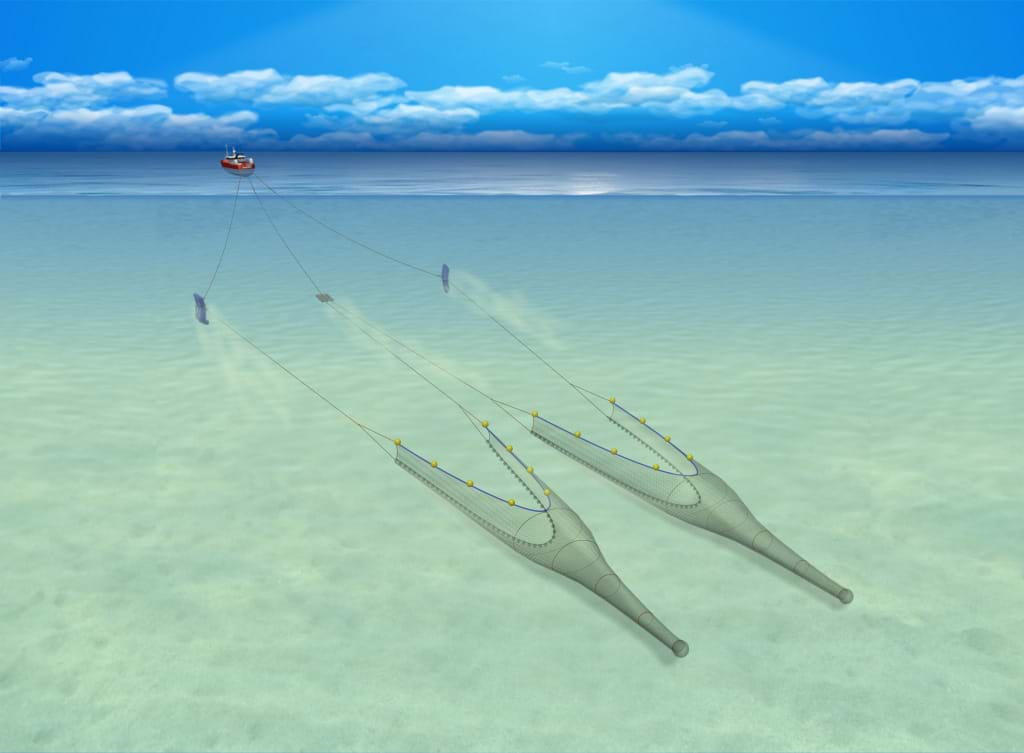Twin Rig Trawl - Mixed species twin rig
Alternative names
-
- Twin rig
- Fish twin rig
Summary
This method uses two trawls side by side to target a mix of bottom living species and demersal round fish. It uses three trawl warps with standard trawl doors to spread the gear with a clump weight in the centre. Often the nets are scaled down versions of a rock hopper trawl.

Environmental impact
Many mixed species twin rig trawls already use larger mesh sizes in the forward parts of the trawls these help to release many of the smaller fish early in the capture process. This large mesh will get gradually smaller the further back in the trawl until the cod-end that is usually of the minimum regulation mesh size.
However, more and more skippers are starting to use larger mesh to release more of the smaller fish and cut down on discards. With larger mesh sizes and sections of different mesh orientation (T90, square mesh) this gear can be made very effective at preventing capture of smaller fish of all species. However, as the gear can be towed over a range of seabed types it has the potential to target several different species, often during the same towing operation, this can create problems with species selectivity, possibly leading to problems with quota allocation.
Seabed impact
As with all multi rig trawls there will be a certain degree of seabed impact with the trawl doors and clump weight. When used properly the weight of any trawl door on the seabed will be much reduced compared to its weight on land. In most demersal trawl fisheries the weight of the trawl door and clump weight on the seabed will be approximately 20-25% of its weight in air. This is due to several factors. One is about an 8 -10% reduction due to the weight of steel and other materials in water.
The other major factor is the tension of the gear behind the trawl door and the uplift from the warp towing the trawl door. The ground gear on these trawls is made up of large rubber discs spaced out using smaller rubber discs between them with it all threaded onto either wire or chain. Although this can look very heavy and cumbersome, it is quite light on the seabed due to the low density of the rubber and canvas in the rubber hopper discs. The gear is designed to ‘bounce’ easily over the hard rough ground. This all helps to minimise the impact of the net and ground gear on the seabed.
Other information
This is another version of the standard three warp twin rig set up. Although the main concept of multi rig systems is to enable the vessel to cover a wider area of seabed with no increase in drag, this method evolved to be able to efficiently target both bottom living species and some of the round fish living slightly higher in the water column.
Generally the vessels using this method will, on average be catching about 50% bottom fish and 50% round fish. It was found that by altering the length of the centre warp the skipper was able to pull it in and make his gear suitable for targeting round fish as well as the bottom fish, by slacking back again on the centre warp he could get the gear to close up slightly and be more suitable for the slower swimming bottom species.
The nets are usually just scaled down versions of a rock hopper trawl spread by a set of trawl doors and a clump weight on the middle warp to keep the centre of the two nets on the seabed. This clump weight can be a roller style or just a clump of heavy chain. The clump weight generally weighs about 1.5 times the weight of one trawl door. This is in the same proportions with the expected tension in each warp.
Documents
-
Effects of Codend Mesh Size and Twine Number on Nephrops Selectivity
-
Increasing codend mesh size and inserting a square mesh panel to reduce discards of haddock and whiting in a seine net
-
More prawns and fewer cod caught in trials with multi-rig prawn trawl (2009)
Gear classification
Main target species (UK)
-
- Any demersal species
- Cod
- Haddock
- Lemon Sole
- Megrims
- Monkfish
- Nephrops
- Plaice
- Pollack (Lythe)
- Saithe
- Whiting
- Witch
Possible bycatch
-
- Any demersal species
- Juveniles of the target species